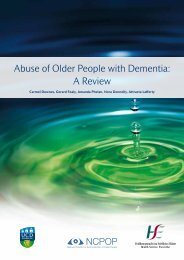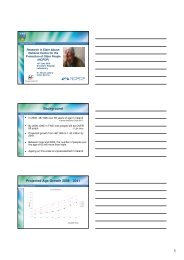Public Perceptions of Older People A literature review
Review 1 PP OP.pdf - National Centre for the Protection of Older ...
Review 1 PP OP.pdf - National Centre for the Protection of Older ...
You also want an ePaper? Increase the reach of your titles
YUMPU automatically turns print PDFs into web optimized ePapers that Google loves.
Research studies carried out on the stereotypes <strong>of</strong> older people have identified<br />
positive, as well as neutral and negative elements in people’s perceptions held<br />
<strong>of</strong> ageing and older people (Robinson et al. 2008). According to Palmore<br />
(1999) many <strong>of</strong> the most commonly held stereotypes reflecting old age are<br />
tw<strong>of</strong>old with many reporting older people in a negative light as well as<br />
corresponding positive stereotypes that are almost a direct opposite. For<br />
example, Cuddy et al. (2005) reported that mainstream societal stereotypes<br />
perceive elderly people as warm (positive) but also as incompetent<br />
(negative). Similarly, Barrett and Cantwell (2007) examined age-related<br />
stereotypes using student drawings <strong>of</strong> elderly people and found that the<br />
sketches depicted both negative and positive stereotypes. In a follow on<br />
study, students examined and discussed a similar sample <strong>of</strong> drawings <strong>of</strong> older<br />
people (Barrett & Pai 2008). Examples <strong>of</strong> words students associated with the<br />
positive sketches included wise, knowledgeable, experienced, patriotic and<br />
“golden ager”. However the list describing the negative stereotypes was<br />
substantially longer and consisted <strong>of</strong> descriptors such as shrewd, greedy,<br />
selfish, stubborn, and grumpy. Other words included lonely, depressed,<br />
closed-minded, boring, wrinkled, forgetful, and technologically challenged.<br />
<strong>Older</strong> people have also been described as pessimistic, difficult, grouchy and<br />
irritable (Tan et al. 2004). <strong>Older</strong> men, in particular have been viewed as<br />
‘intolerant, suspicious and conflictive’ more so than older women (Arnold-<br />
Cathalifaud et al. 2008; Narayan, 2008). Although both positive and negative<br />
descriptors <strong>of</strong> older people are presented, it is evident from the substantive<br />
list above that more negative descriptors are associated with older people.<br />
This finding is consistent with Sauer (2006) who reported that students were<br />
three times more likely to use mostly negative rather than positive descriptors<br />
to characterize older adults. Furthermore, Palmore (1981) found that seven <strong>of</strong><br />
the nine most frequent misconceptions <strong>of</strong> older people tend to reflect negative<br />
stereotypes. Similar studies have also reported that older people are more<br />
likely to be negatively stereotyped (Gellis et al. 2003; Kite et al. 2005;<br />
Musaiger & D’Souza 2009). Arnold-Cathalifaud et al. (2008) concluded that,<br />
although no one stereotype <strong>of</strong> old age exists, old age is generally perceived as<br />
a stage in which the positive characteristics <strong>of</strong> life, such as health, are lost.<br />
<strong>People</strong> <strong>of</strong>ten construct their perceptions <strong>of</strong> older people based on stereotypes,<br />
which tend to be fixed beliefs and are assumed to apply to all older people.<br />
Although, these stereotypes tend to be tw<strong>of</strong>old, it is evident from the<br />
13









